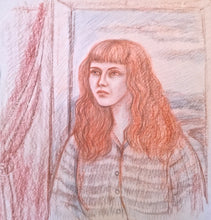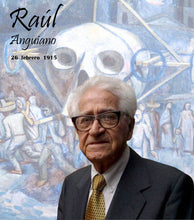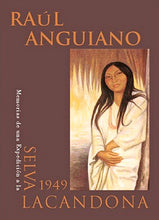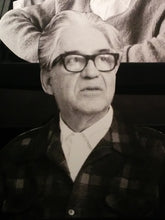In 1937 Anguiano joined the Revolutionary Writers and Artists League. Together, with Alfredo Zalce and Pablo O'Higgins, he was also a founding member of thePopular Graphics Workshop, where artist practised a graphic style based on Mexico's folk traditions. This was due to the powerful influence of the recently discovered Jose Guadalupe Posada and Goya.
Raúl Anguiano belongs to the so-called "Third Generation" of post-revolutionary painters, along with Juan O'Gorman, Jorge González Camarena, José Chávez Morado, Alfredo Zalce, Jesús Guerrero Galván and Julio Castellanos, all known for being unorthodox, associated in politics and in art, while at the same time, holding to certain traditional canons. Anguiano's work is viewed as an expression of its time because of its undeniably Mexican flavour, and the link to his people is clear, not only in his murals but also on canvas, etchings, pencil and ink drawings, lithographs and illustrations, and also more recently in sculpture and ceramics. Without compromising his personality or ethnic roots, and at the same time not allowing them to limit him, Anguiano has vindicated and taken advantage of the principles of modern art, giving him a universal and transcending character of his boundary work.
Anguiano held his first solo exhibition, entitled "Raúl Anguiano and Máximo Pacheco" at the Palace of Fine Arts in Mexico City, in 1935; and in 1940 he took part in his first collective exhibition "Twenty Centuries of Mexican Art". These were followed by more than 100 shows in many countries as Cuba, Chile, Colombia, Brazil, United States, France, Italy, the former Soviet Union, Israel, Germany and Japan. His most recent exhibitions include the presentation of a series of four colour lithographs, held at the Hall of Graphic Arts SAGA 88, from 1989 to 1990, in Paris; and the retrospective look at Anguiano's work in graphics (1938-1940), held at the National Print Museum in Mexico City in 1990.
MLA Gallery guarantees the authenticity of all of the Latin Master prints with an unconditional guarantee of authenticity, on the gallery letterhead. In addition, we offer a lifetime trade in policy, for the full purchase price. Please inquire about details.
During the 1980s, many artists living in Mexico began to seek new alternatives to the forms of expression that had dominated Mexican art of the 1960s and 1970s, especially international trends such as abstraction. A number of painters sought to evoke dream-like fantasy in their art, creating vibrant and symbolic images which often integrated traditional elements of Mexican iconography.
Principal among these artists was a re-interpretation of Mexican identity, as well as the intense inward scrutiny of the artists’ individuality. Issues of gender –i.e., feminism and personal solutions to the socio-political role of the artists in a developing nation, were manifested in much of the work during this intense period.
Today, thanks to dynamic artists, galleries and patrons and the globalization of the world art scene, contemporary Mexican art is reaching galleries the world over. Mexico City has become an international art hot spot, while other cities such as Monterrey, Oaxaca, Mazatlán and Guadalajara also have thriving art scenes. Mexican artists attempt to interpret the uncertainties of the 21st century in diverse ways. The pendulum has swung away from abstraction to hyper-representation, photorealism, installations, video and street art.
Some describe the scene in Mexico City in terms of a boom or an explosion. But the truth is that art has thrived there for a century — from the great muralists like Diego Rivera in the 1920s; via the abstract painters of the Ruptura movement in the 1950s; and the conceptually-inclined ‘Friday Workshop’ artists in the 1990s; through to today. What has changed in the past two decades is the artistic infrastructure. A rich gallery sector and fairs such as Zona Maco have emerged, thanks to a fast-growing collector base.
Political stability and economic prosperity are key factors here. The capital has been immune to the drug-related violence that afflicts much of the rest of Mexico. Incomes have also risen steadily since the country signed NAFTA (the North American Free Trade Agreement) with Canada and the US in 1994. Economists predict Mexico will have the world’s fifth-biggest economy by 2050.
One of Mexico City’s strengths is that the rules of the art game are less fixed here than they are in more established art centers. The focus in this city, for a long time, used to be on traditional work in traditional places… Awareness of contemporary art has developed [only relatively recently — which] has allowed more room for experimentation, the unstructured and the unexpected, combined with the international connectivity brought by the internet, which has let Mexicans plug into art-world trends and discourse like never before.
No discussion of culture in Mexico City is complete without mention of its museums: there are more than 150 in total, surpassing every city on Earth, bar London. The National Museum of Anthropology is a must for any visitor, though the biggest change on the landscape has been the recent building of new art museums. The standouts from the past dozen years include the Soumaya Museum (showing the collection of Mexican telecoms magnate Carlos Slim); the Jumex Museum (housing the art of businessman Eugenio López Alonso); and Museo Universitario Arte Contemporaneo (MUAC), with its collection of mainly Mexican art from 1952 onwards.
‘Mexico is a large, highly centralised nation — and the capital is its stage,’ says Minerva Cuevas, an artist born and bred in Mexico City. ‘People from the rest of the country flock here for work, so public space is constantly being negotiated’.
It is also a young city: the average age of its citizens is 26, meaning there should be no lack of creative energy to maintain a thriving cultural scene. ‘That’s absolutely crucial,’ says Gabriela Lobo, Managing Director of Christie’s Mexico. ‘The scene here is vibrant and youthful, with lots of artists, buyers and sellers all still in their twenties. As impressive as things are currently, in many ways it’s just planting the seed for an even more impressive future.’








